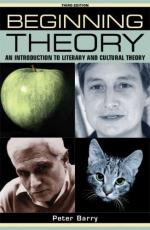
|
| Name: _________________________ | Period: ___________________ |
This test consists of 5 multiple choice questions, 5 short answer questions, and 10 short essay questions.
Multiple Choice Questions
1. Ecocritics emphasize writers who highlight ________ as their subject matter.
(a) Feminists.
(b) Animals.
(c) Nature.
(d) Children.
2. The British critic ________ described cultural materialism as "a politicized form of historiography."
(a) Graham Holderness.
(b) Robertson Davies.
(c) W. Somerset Maugham.
(d) Charles de Lint.
3. According to the narrator, Sandra Gilbert and Susan Gubar's "The Madwoman in the Attic" contained ________ passing reference to lesbianism.
(a) 9.
(b) 20.
(c) 1.
(d) 3.
4. Who wrote the following statement, which is found in the chapter "Postcolonial Criticism": "We cannot easily say that since Mansfield Park is a novel, its affiliations with a particularly sordid history are irrelevant or transcended, not only because it is irresponsible to say that, but because we know too much to say so with bad faith"?
(a) Said.
(b) Gates.
(c) Marx.
(d) Freud.
5. The term "reification" was used in Karl Marx's major work ________, and it concerned the way, when capitalist goals and questions of profit and loss are paramount, workers are bereft of their full humanity and are though of as "hands" or "the labor force."
(a) The German Ideology.
(b) The Poverty of Philosophy.
(c) Das Kapital.
(d) The Communist Manifesto.
Short Answer Questions
1. The narrator explains that conventional ________ is often seen by the stylistician as impressionistic, intuitive, and randomized.
2. Who does Peter Barry credit with partially defusing the conflict between heterosexual feminists and lesbians in an important essay which introduced the notion of the "lesbian continuum"?
3. According to the chapter titled "Postcolonial Criticism," in its earliest phase, post-colonial criticism took as its main subject matter ________ representations of colonial countries and criticized these for their limitations and their bias.
4. Which of the following two writers were stigmatized as exemplars of "bourgeois decadence"?
5. Which of the following terms is defined as the view that, in spite of the connections between culture and economics, art has a degree of independence from economic forces?
Short Essay Questions
1. What is the aim of Marxism, according to the narrator?
2. Explain the meaning of "adopt," "adapt," and "adept" phases as they relate to post-colonial criticism.
3. Briefly discuss what post-colonial critics do according to the narrator.
4. In what way does the narrator say queer theory differs from lesbian feminism?
5. What was the "Vulgar Marxism"?
6. Briefly explain new historicism as it is described by the author.
7. What do ecocritics do according to Peter Barry?
8. What is narratology?
9. Briefly define "mimesis" and "diegesis" as determined by Peter Barry.
10. What does ecocriticism study? What is another term for ecocriticism?
|
This section contains 792 words (approx. 3 pages at 300 words per page) |

|




